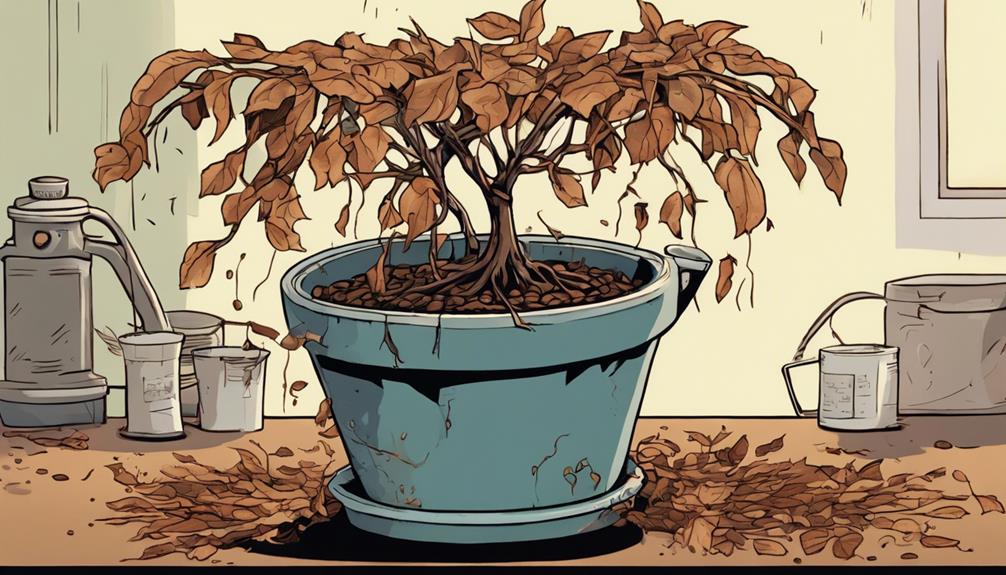To revive your wilting coffee plant, begin by cutting off any dried leaves and branches. Ensure proper watering, provide indirect sunlight, and increase humidity levels. Additionally, transplant it into fresh soil. Remember to avoid excessive watering, direct sunlight, and consistently monitor soil quality while regularly trimming. A healthy coffee plant features vibrant green leaves, sturdy stems, and is pest-free. Maintain consistent watering and humidity control to prevent dryness. If your plant displays symptoms of decline such as yellowing leaves or drooping, adjust watering, light exposure, temperature, fertilization, and address any pest issues effectively.
Key Takeaways
- Trim off dead branches and leaves to promote new growth.
- Adjust watering to prevent over or under-watering.
- Ensure indirect sunlight exposure for optimal growth.
- Increase humidity levels for a healthier environment.
- Consider repotting in fresh, well-draining soil for revitalization.
Symptoms of Dying Coffee Plant
If your coffee plant is showing symptoms of wilting or dropping leaves, it may be indicating a lack of water and nutrients. Wilting leaves that are limp, flat, and pointing downward are clear signs of a coffee plant in distress.
This decline in the plant's health could be due to collar rot caused by excess moisture, leading to root damage and further wilting. The sudden deterioration in overall plant health, accompanied by signs of stress and potential disease, shouldn't be overlooked.
Dry roots can also contribute to wilting and a lack of new growth, further signaling plant distress. It's vital to address these symptoms promptly to prevent irreversible damage to your coffee plant.
Monitoring the watering schedule, ensuring proper drainage, and providing balanced nutrition are essential steps in reviving a struggling coffee plant. By recognizing these symptoms early and taking appropriate action, you can help bring your coffee plant back to vibrant health.
Reviving Techniques for Coffee Plant

To revive your struggling coffee plant, begin by trimming off all the dried leaves and branches to encourage new growth.
Make sure to water the plant thoroughly but avoid overwatering or underwatering to prevent issues like root rot.
Place the plant in a location with indirect sunlight to help it recover.
Increasing humidity levels by using a humidifier or misting the plant can also aid in its revival.
Additionally, consider repotting the plant in fresh, well-draining soil to provide it with ideal growing conditions.
By following these steps and providing the right care, you can help your coffee plant bounce back to health and thrive once again. One way to provide the right care for your coffee plant is by ensuring it has adequate sunlight, water, and well-draining soil. It’s important to monitor the plant for any signs of pests or disease and address them promptly. Furthermore, a helpful tip is to apply coffee grounds to tomato plants, as this can provide them with essential nutrients and improve their overall health. Remember, with patience and proper care, your coffee plant can recover and flourish.
Common Care Mistakes to Avoid
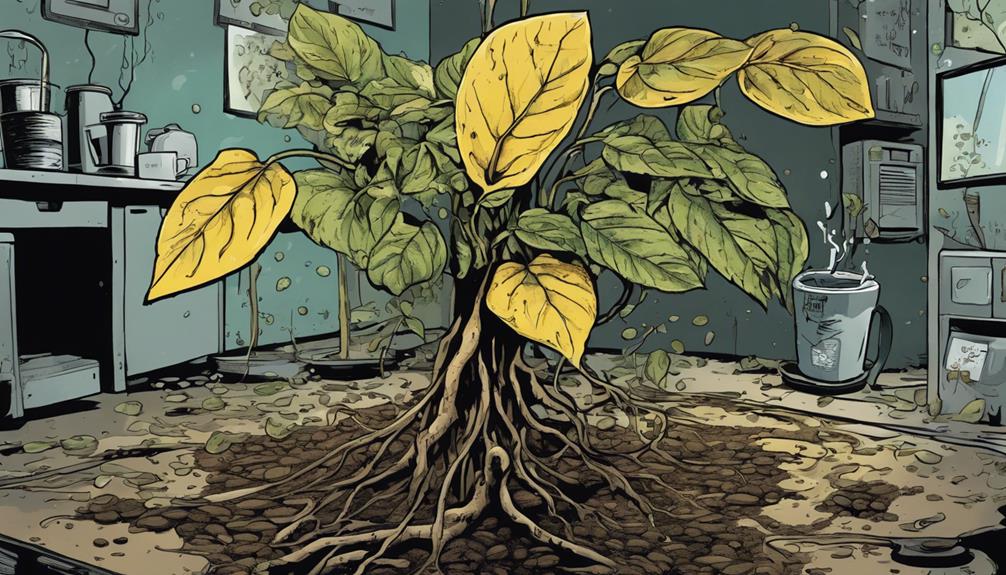
You can enhance your coffee plant's health by avoiding common care mistakes.
Overwatering can lead to root rot, while direct sunlight for extended periods may cause leaf burn.
Make sure you use quality soil and keep up with regular pruning to maintain the plant's overall health.
Care Missteps
Avoid overwatering, exposing to direct sunlight for extended periods, using subpar quality soil, neglecting regular pruning, or disregarding signs of stress in your coffee plant to ensure its health and growth.
Overwatering can lead to root rot and decline in coffee plants, while excessive sunlight exposure can harm them. Make sure that your coffee plant isn't receiving enough water and sunlight, as these factors are essential for its well-being.
Additionally, using low-quality or compacted soil can impede the plant's growth, so opt for high-quality, well-draining soil instead. Remember that pruning helps in maintaining the plant's shape and health, so don't overlook this aspect of plant care.
Lastly, always pay attention to any signs of stress or disease in your coffee plant, as neglecting them can lead to irreversible damage. By being mindful of these common care missteps, you can effectively bring your coffee plant back to life.
Avoiding Pitfalls
Common care mistakes can greatly impact the health and growth of your coffee plant, so it's essential to be mindful of these pitfalls to safeguard its well-being. Here are three key pitfalls to avoid when reviving your dying plant:
- Overwatering or Underwatering: Finding the right balance in watering is vital. Overwatering can lead to root rot, while underwatering can cause the plant to dry out and decline. Make sure the soil is moist but not waterlogged.
- Sunlight Exposure: While plants need sunlight to thrive, exposing the coffee plant to direct sunlight for prolonged periods can scorch the leaves and hinder growth. Find a balance by providing adequate light without causing damage.
- Soil Quality: Using poor quality or compacted soil can restrict root growth and nutrient absorption, impacting the plant's overall health. Choose well-draining soil that provides the necessary nutrients for revival.
Signs of a Healthy Coffee Plant
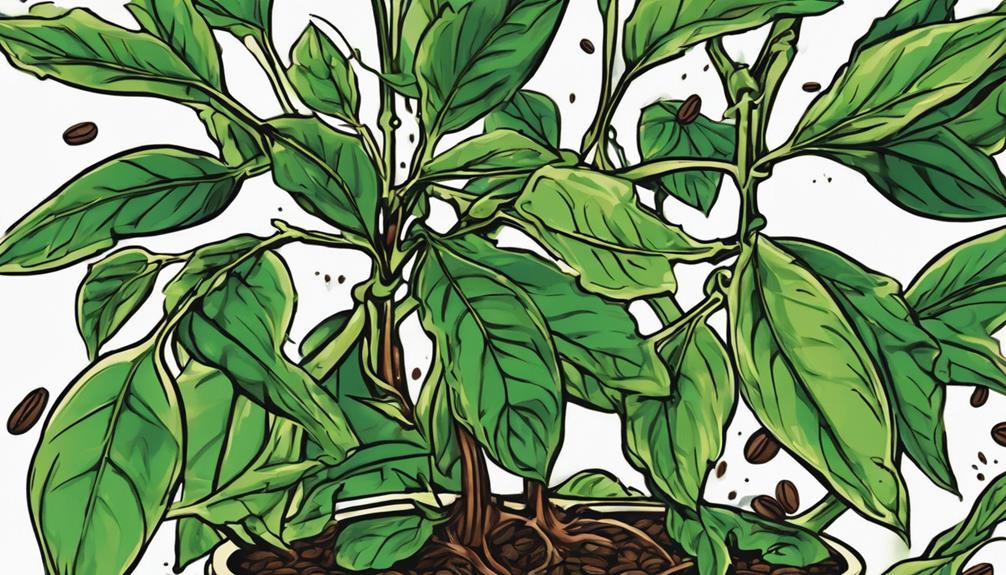
To determine if your coffee plant is thriving, look for vibrant green leaves, new growth, and a firm stem. These indicators show that your plant is healthy and well-cared for, ensuring its overall robustness.
Keep an eye out for these signs to maintain a flourishing coffee plant.
Healthy Growth Indicators
Healthy growth indicators for a coffee plant include vibrant green leaves, new growth and shoots, a firm stem, moist soil, and freedom from pests or diseases. When your coffee plant boasts these characteristics, it's a good time to celebrate its health and thriving nature.
Here are three key signs to look out for:
- Vibrant Green Leaves: The rich green color of the leaves signifies that your coffee plant is receiving adequate sunlight and nutrients, essential for its well-being.
- New Growth and Shoots: Witnessing fresh growth and shoots emerging from your plant indicates that it's actively growing and expanding, a positive sign of a healthy coffee plant.
- Firm Stem: A sturdy and firm stem demonstrates that your coffee plant has good structural integrity, supporting its growth and development effectively.
When your plant looks this good, it's a sure sign that you're providing the right care and environment for your coffee plant to thrive.
Vital Signs of Health
After observing the lively green leaves, new growth, and sturdy stem of your coffee plant, it's also important to recognize the crucial signs that indicate its overall health and well-being. Here are some essential signs of a healthy coffee plant:
| Crucial Signs of a Healthy Coffee Plant | Description |
|---|---|
| Lively Green Leaves | Indicates active photosynthesis and good nutrient uptake. |
| New Growth and Shoots Emerging | Shows the plant is actively growing and developing. |
| Sturdy and Robust Stem | Signifies a strong support structure for the plant's overall health and well-being. |
Checking for these essential signs regularly can help you guarantee that your coffee plant is thriving. Remember, a healthy coffee plant should have moist but not waterlogged soil, be free of pests or diseases, and be placed in a location with bright, indirect sunlight to support its growth and vitality. Keep a close eye on these indicators to help your plant stay healthy and happy.
Tips for Preventing Drying Out
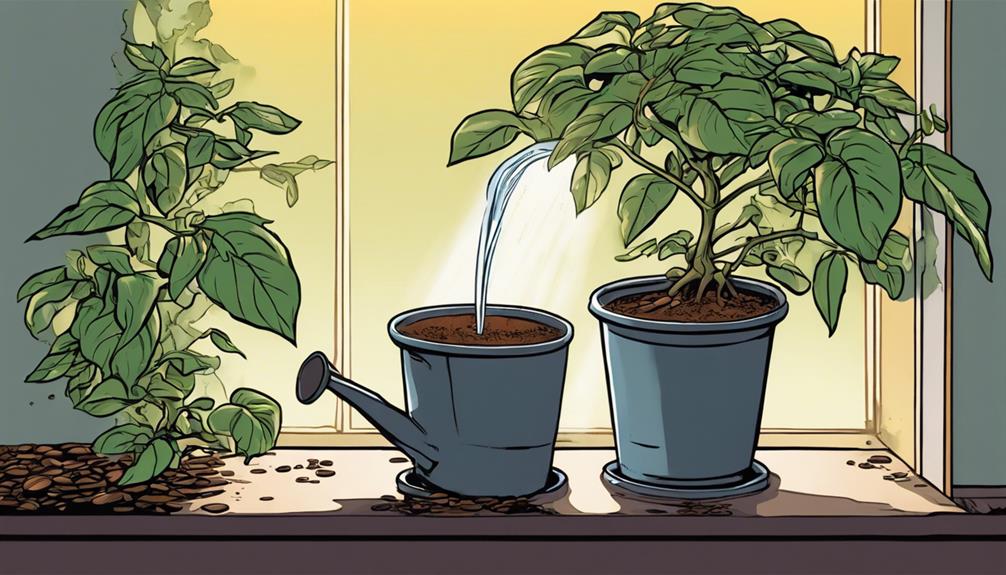
Maintain a consistent watering schedule to prevent your coffee plant from drying out. Adequate hydration is vital for its well-being.
Here are three essential tips to help you keep your coffee plant thriving:
- Watering Schedule: Set a regular watering routine based on the plant's needs. Check the soil moisture regularly to make sure it's neither too dry nor waterlogged.
- Humidity Levels: Increase humidity around the plant by misting its leaves or using a humidifier. This helps prevent moisture loss through transpiration.
- Temperature Control: Avoid exposing the plant to sudden temperature changes or drafts. Keep it in a stable environment to maintain stress and dehydration.
Coffee Plant Decline Causes
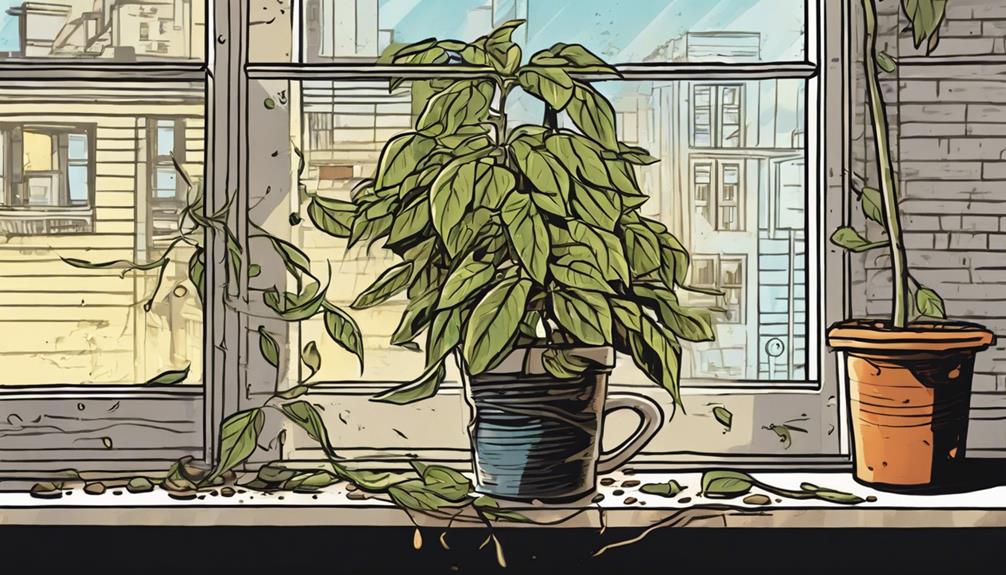
To understand why your coffee plant might be declining in health, one must recognize the common causes behind its deterioration. Overwatering is a leading offender, as it can lead to root rot and hinder nutrient absorption. Conversely, underwatering deprives the plant of essential moisture, causing wilting and yellowing of leaves.
Incorrect light conditions, whether too much or too little, can also stress the plant and disrupt its growth cycle. Furthermore, pest infestations such as leaf rust and coffee borer beetles pose serious threats to the well-being of your coffee plant.
Recognizing the signs of a struggling coffee plant, such as yellowing leaves, blackened tips, wilting, stunted growth, or sparse foliage, is essential for timely intervention. Adjusting watering schedules, ensuring proper light exposure, maintaining suitable temperature and humidity levels, providing adequate fertilization, and implementing effective pest control measures are key steps in reviving a declining coffee plant.
Frequently Asked Questions
How to Revive a Dying Coffee Plant?
To revive a dying coffee plant, trim off dried leaves, water thoroughly without overdoing it, place in shade with indirect sunlight, boost humidity with a humidifier or misting, and repot in fresh, well-draining soil for recovery.
Can You Save a Coffee Plant?
You can save a coffee plant! Assess its condition, adjust watering, prune dead leaves, maintain proper light and humidity, and be patient. With care and attention, your coffee plant has a good chance of revival.
Why Is My Coffee Plant Not Doing Well?
Feeling like a detective, you wonder why your coffee plant isn't thriving. Check for overwatering, pests, light issues, or diseases. Adjust care routine promptly by tweaking water, light, nutrients, and pest control for revival.
Why Is My Coffee Plant Turning Brown?
Your coffee plant may be turning brown due to various factors like overexposure to sunlight, nutrient deficiencies, pests, low humidity, or irregular watering. Address these issues by adjusting light, providing nutrients, and maintaining proper care for revival.
Conclusion
Now that you have learned how to revive a dying coffee plant, remember that over 40% of coffee crops are at risk due to climate change. It is essential to be proactive in caring for your coffee plants and take measures to protect them from the effects of climate change. Consider using sustainable farming practices and investing in shade-grown coffee to help mitigate the impact of rising temperatures on your crops. Additionally, seeking out resources and information on tomato plant care tips can provide valuable insights into managing and maintaining healthy coffee plants in changing environmental conditions.
By taking better care of your own plant, you're contributing to the preservation of this beloved and essential crop.
So show your coffee plant some love and watch it thrive once again!
